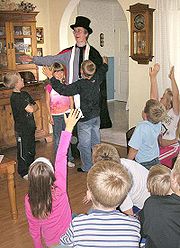
Children's magic
Encyclopedia

Parlor magic
Parlor magic is done for larger audiences than close-up magic and for smaller audiences than stage magic. In parlor magic, the performer is usually standing and on the same level as the audience, which may be seated on chairs or even on the floor. According to the Encyclopedia of Magic and...
and is meant to entertain children. It is typically performed at birthday parties, churches, preschools, elementary schools, Sunday Schools or libraries. It is often the only type of magic most Westerners experience other than that seen on television. This type of magic is usually comedic in nature.
A distinction should be made between Children's magic and "young magicians." The former is meant for audiences made up of mostly children while the latter refers to performers who are under-aged. The later has organizations dedicated to them including Society of Young Magicians
Society of Young Magicians
The Society of Young Magicians is a group of magicians, age seven through seventeen, which is sponsored by the Society of American Magicians. The Society of Young Magicians has clubs, known as "assemblies" around the world usually associated with an adult S.A.M group.Youth aged 7 through 17 may...
, Magic Youth International
Magic Youth International
Magic Youth International is the highly respected junior branch of the International Brotherhood of Magicians . The global membership of the I.B.M. actively supports this dynamic youth-focused program to promote, educate and enhance the activities of young magicians around the world.Magic Youth...
and Young Magicians' Club.
Not every magician is interested in performing for children both artistically and in terms of patience. When Br. John Hamman
John Hamman
Brother John Charles Hamman S.M. was a Catholic Marianist Brother and professional close-up magician. The tricks he invented are still an integral part of many close-up magician's repertoire....
, sm, was honored in 1995 during the first St. Louis Magical Heritage Awards, he explained in his acceptance speech the key to a successful magic performance:
Since children do not have the natural social filters adults have in such situations, they have no compunction against pointing out every error or inconsistency a magician makes during his performance. This makes performing for children exceedingly difficult.
Children's magicians often use certain gambits while performing for children. Some performers use their knowledge to intentionally misdirect the children in a given audience. One form of this type of misdirection is referred to as "Magician-in-Trouble" wherein a performer pretends to have made a mistake.
The style used for children's magic is often comical and frequently uses props
Theatrical property
A theatrical property, commonly referred to as a prop, is an object used on stage by actors to further the plot or story line of a theatrical production. Smaller props are referred to as "hand props". Larger props may also be set decoration, such as a chair or table. The difference between a set...
that are large and colorful.
It is not uncommon for magicians to dress as clowns or in wild and outlandish costumes while performing.
Generally, children's magicians are reluctant to use tricks that focus on the use of playing cards, however magic with coin
Coin
A coin is a piece of hard material that is standardized in weight, is produced in large quantities in order to facilitate trade, and primarily can be used as a legal tender token for commerce in the designated country, region, or territory....
s (see Coin magic
Coin magic
Coin magic is a general term for magical performances employing one or more coins which are manipulated to deceive and baffle the audience. Because coins are small, much coin magic is considered close-up magic or table magic, as the audience must be close to the performer to see the effects...
) or paper money frequently popular with children. Movement and action are preferable to patter
Patter
Patter is a prepared and practiced speech, that is designed to produce a desired response from its audience. Examples of occupations with a patter might include the: auctioneer, salesperson, dance caller, or comedian....
. Buffoonery is a better vehicle than "mystery" for children. These performers commonly use as many audience members as impromptu assistants as possible. Common Children's Magic Props include: Run Rabbit Run, Hip Hop Rabbits, Change Bag Routines, Breakaway Wand, Tipsy Turvy Bottles, and Spongeballs.
Older children (from 7 upwards) tend to have a far greater logic and less traditional and more innovative magic effects can be performed.
Children's magicians
- Most popular childrens entertainer
- Bo The Irish Magician - Really Grand Events
- David Ginn
- Samuel Patrick Smith
- Joseph Fields
- The Great Houdinni
- Mary Morris
- Peter O'Malley
- Paul Saulsbury
- Markus (Almodarr) Steelgrave
- Mr Giggles / Pirate Pete Children's Birthday Party Specialist
- Mr. Phil & Co.
- Matt Stevens Birthday Party Magician

